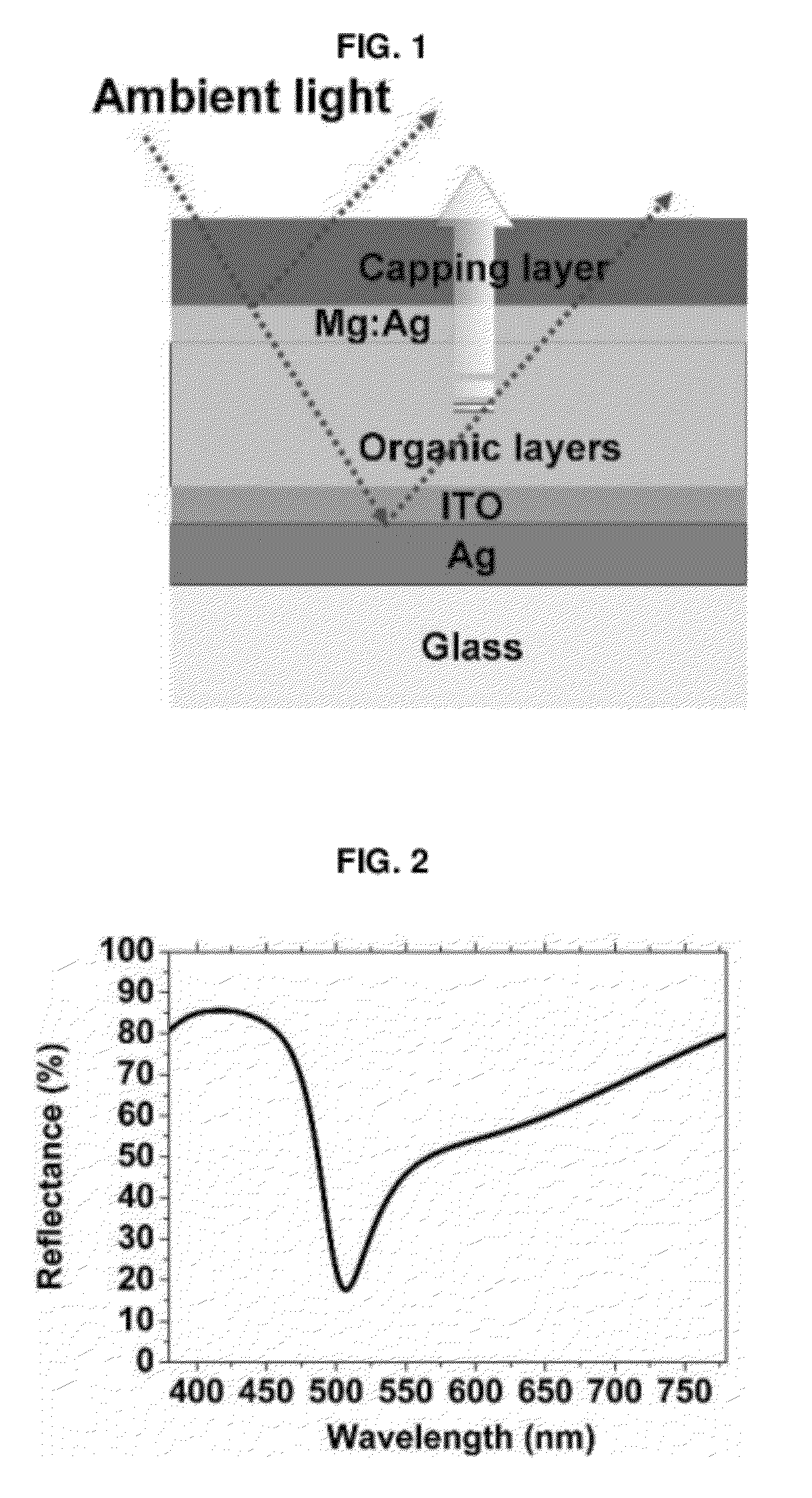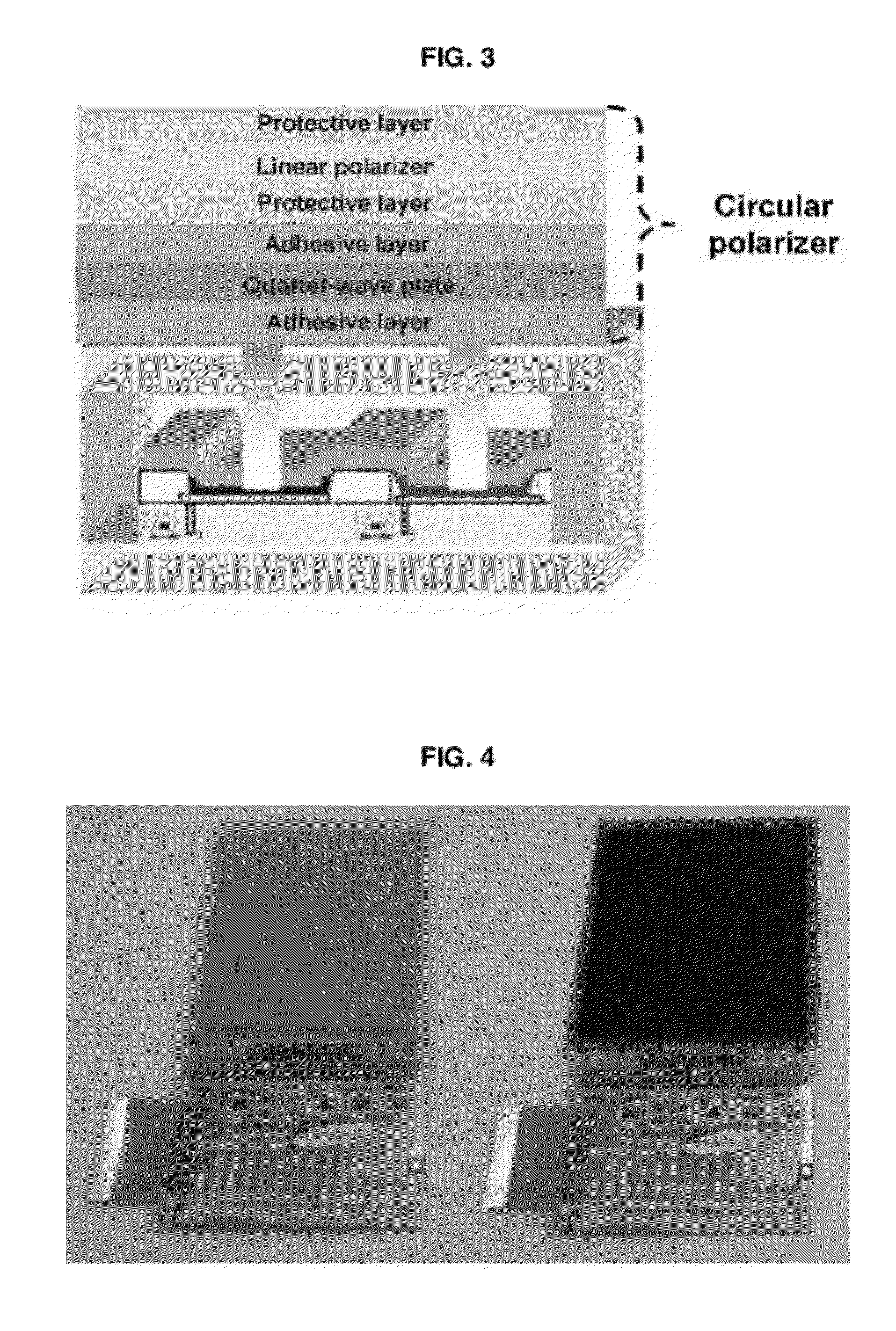Black organic light-emitting diode device
a light-emitting diode and organic technology, applied in the manufacture of electrode systems, electric discharge tubes/lamps, discharge tubes luminescnet screens, etc., can solve the problems of reducing contrast and visibility, affecting the photoefficiency of the device, so as to reduce the reflection of external light, reduce the thickness of the device, and improve the effect of photoefficiency
- Summary
- Abstract
- Description
- Claims
- Application Information
AI Technical Summary
Benefits of technology
Problems solved by technology
Method used
Image
Examples
example 1
[0087]Cr was used as a second metal layer 70, and SiO2 was used as both a phase matching layer (a first interlayer 60) and a phase compensation layer (a second interlayer 80). In the present invention, a transfer matrix type was adopted, which was adapted for reflection and transmission of a thin layer configuration. Such a transfer matrix type suitable for use in many optical coating and optical filter designs was described well in “Thin-Film Optical Filter, 3rd ed.” by Macelod.
[0088]FIG. 9 illustrates the external light reflectance depending on changes in the thickness of the phase matching layer (the first interlayer 60) and the phase compensation layer (the second interlayer 80). FIG. 14 illustrates changes in reflection of external light depending on the thickness of the phase matching layer (the first interlayer 60). In the drawing, the parenthesized numerals indicate luminous reflectance values, and the smallest reflectance is obtained when SiO2 is 60 nm. FIG. 15 illustrates ...
example 2
[0089]When Cr was used as the second metal layer 70 and SiO2 was used as the phase matching layer (the first interlayer 60) and the phase compensation layer (the second interlayer 80), results depending on changes in thickness of the second electrode 50 using Mg:Ag were analyzed.
[0090]FIGS. 18 and 19 are graphs illustrating the external light reflectance and the efficiency depending on changes in the thickness of the second electrode 50. In Example 1, the thickness of the second electrode 50 was 18 nm which is the same as in the conventional OLED. As such, the external light reflectance was about 2.9%, and the efficiency was improved by about 3% compared to the conventional OLED.
[0091]However, as the thickness of Mg:Ag which is the second electrode 50 decreases, the efficiency is improved and the external light reflectance is increased. At about 16 nm, the external light reflectance is 3.7% and the efficiency is improved by about 26%.
[0092]The thickness of the Mg:Ag electrode can be...
example 3
[0093]Cr was used as a second metal layer 70, and SiNx was used as a phase compensation layer (a second interlayer 80) and a phase matching layer (a first interlayer 60).
[0094]FIGS. 20 and 21 are graphs illustrating the external light reflectance and the efficiency when the thickness of the phase compensation layer (the second interlayer 80) made of SiNx is 60 nm and the thickness of Cr is 10 nm. For example, when the thickness of the phase matching layer (the first interlayer 60) is 50 nm, the external light reflectance is about 4.8%, and the efficiency is improved by about 2%.
PUM
 Login to View More
Login to View More Abstract
Description
Claims
Application Information
 Login to View More
Login to View More - R&D
- Intellectual Property
- Life Sciences
- Materials
- Tech Scout
- Unparalleled Data Quality
- Higher Quality Content
- 60% Fewer Hallucinations
Browse by: Latest US Patents, China's latest patents, Technical Efficacy Thesaurus, Application Domain, Technology Topic, Popular Technical Reports.
© 2025 PatSnap. All rights reserved.Legal|Privacy policy|Modern Slavery Act Transparency Statement|Sitemap|About US| Contact US: help@patsnap.com



